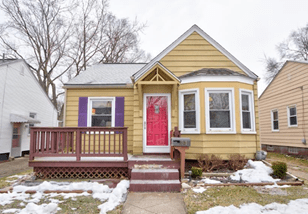In a nutshell:
- General dissatisfaction with a growing property tax burden has led to the adoption of rate limitations, a levy limitation in the 1978 Headlee Amendment, and an assessment limitation with Proposal A of 1994.
- The limitations have succeeded in limiting the growth in property tax revenues and increasing the predictability in yearly tax bills for taxpayers. But they have imposed a modified acquisition value system with an assessment limit on top of a system with a levy limit, making the entire property tax system difficult to understand at times.
- The limitations have also lessened equity among taxpayers with similarly situated properties because their tax bill is directly affected by how long they have owned their property with long-time property owners receiving more tax benefits.
Most Michigan taxpayers have a mixed relationship with the property tax – we love to hate it, but we are also very, very dependent on it to fund an array of public services. The property tax is so detested because it represents such a large financial burden for most taxpayers, in part because it is levied by the state and every level of local government including counties, cities, townships, and public schools. The burden can feel even heavier because the tax is collected only twice a year in large sums, unlike an income tax (small amounts withheld from paychecks) or a sales tax (relatively small amount charged to each taxable purchase).
Given this animosity towards the property tax, it’s no wonder that, over time, taxpayers have sought to place various limits on its use and control how it operates.
The different kinds of property tax limitations
Taxpayers across the country have adopted property tax limitations in their states that take one of three different forms:
- A rate limit creates an upper bound on the tax rate that a governmental unit can levy.
- An assessment limit provides a ceiling to the annual growth in property assessments; that is, it limits how much a taxpayer’s property value can increase year-to-year.
- A levy limit restricts how much a jurisdiction’s tax revenue can grow, generally expressed in year-over-year terms.
The 1963 Michigan Constitution was originally adopted with separate 15-, 18-, and 50-mill rate limitations. These rate limits would appear to provide some real constraints on property taxes, but they only apply to certain local governments and to property taxes supporting general operations.
General unhappiness with the effectiveness of the rate limitations led to inclusion in 1978’s Headlee Amendment of provisions requiring direct voter approval for new taxes and instituting a levy limit, which requires a local government’s millage rate to be rolled back if revenue grows at a rate greater than inflation.
Since the Headlee Amendment’s rollback mechanism applies to the average increase in a jurisdiction across all classes of property, substantial increases in the assessments of residential properties may be offset by decreases or modest increases in other classes of property. On occasions when increases in some property tax bills were offset by decreases in others, the millage rate was not rolled back (or at least not rolled back as much). This led to individual property owners still experiencing increases in their property tax bills that were much greater than inflation.
This shortcoming of the Headlee Amendment helped lead to inclusion in 1994’s Proposal A of an assessment limit on property value growth for individual parcels.
Beginning in 1995, the market-value based system of assessing property was replaced with a modified acquisition value system as the property tax base. Prior to Proposal A, property was assessed based on state equalized value (SEV), which is linked to market value; since Proposal A, property is assessed on taxable value (TV) with increases for each parcel of property constitutionally limited to five percent or the rate of inflation, whichever is less. When property is sold, its tax base reverts back to SEV, which typically results in a one-time jump in the property’s TV. After the sale, annual TV increases are capped again with the new owner.
Since Proposal A was superimposed on the current system with Headlee Amendment limitations, we see transfers in property ownership causing TVs to “pop-up” to SEV. Those pop-ups cause the TV of local governments to grow faster than the rate of inflation and lead to Headlee tax rate rollbacks.
What does this mean for the Michigan property taxpayer?
The effectiveness of property tax rates, limits, and revenues may be judged differently by a taxpayer than by a local government official trying to fund services in their community. Good tax policy generally meets the needs of both taxpayers and government.
For now, let’s focus on taxpayers. Effective tax policy for taxpayers provides:
- Limits on growth in tax burdens
- Predictability in year-to-year tax bills
- An easily understandable process to determine property value and taxes owed
- Equity with other similarly situated taxpayers
In general, Michigan’s tax limitations have served to limit the growth of taxes collected and to increase year-over-year predictability in tax burden. We have instituted a modified acquisition value system with an assessment limit on top of a system with a levy limit that requires calculation of a millage reduction fraction every year to determine the millage rate; this has increased the difficulty for taxpayers in understanding their yearly tax burden. Understandability is diminished further when property is sold and property values “pop-up” and tax rates are rolled back. As long as a homeowner stays in their property, they can easily calculate their taxes every year because their property value cannot grow more than inflation.
The limitations, especially Proposal A, can also serve to lessen equity among taxpayers. Because Proposal A keeps the property value from increasing greater than inflation for as long as a homeowner keeps their property, it can lead to significant disparities in tax bases, and therefore on the taxes paid on houses of the same market value which receive the same benefits from local government services. This creates situations where a new property owner that moves into a home next to an identical property that has not changed hands for many years could pay substantially higher property taxes than his or her neighbor. The figures below provide a real-life example of how the assessment limitations work in Michigan.

Property “A”
Fielding Street, Ferndale
737 sq. ft., 1942 built
Sold 4/25/1996 for $28,000
Parcel capped since 1997
TV $24,960 x mills (50.2377) = Taxes of $1,254

Property “B”
Northway Street, Ferndale
744 sq. ft., 1942 built
Sold 3/13/2020 for $140,500
Parcel uncapped for 2021
TV $71,290 x mills (50.2377) = Taxes of $3,581
Source: Used with permission from David Hieber, Oakland County Equalization Director, Oakland County Property Tax Overview and Outlook, Oakland Schools, February 26, 2021
The owner of the first house on Fielding Street in Ferndale, who has owned the house since 1997, has a taxable value of only $24,960 and pays $1,254 in taxes. Just one street to the north, the owner of a similarly sized house on Northway Street purchased the house in 2020 and in 2021 will have a taxable value of $71,290 and be paying $3,581 in taxes. The property owner on Northway Street does not receive any extra services for paying almost three times as much taxes as the owner of the Fielding Street property. Examples like this can be found throughout the state and at all property valuations of similarly situated properties in the same jurisdiction paying different tax amounts based on years of ownership.
The Headlee Amendment plays into this scenario because when the second house was sold in 2020, its taxable value popped-up to market value. If enough pop-ups occur during a year, it can cause local government property tax revenues to grow faster than inflation. This in turn will lead to their millage rate being rolled back to satisfy the Headlee limitation. So, not only does the owner of the first home pay much lower taxes based on a much lower taxable value, but he or she also benefits from any jurisdiction-wide millage rate reductions.
These differences in taxes paid can decrease overall homeowner mobility and create a “lock-in” effect where homeowners who enjoy a substantial tax benefit become less likely to sell because the cost of holding the property is lower and the tax benefits are lost once the property is sold. However, it also provides an element of certainty for those same taxpayers as they know the maximum annual increase in their property assessment (the lesser of inflation or five percent). In effect, they can predict and budget for their property tax burden.
Coming up – implications of tax limitations for local governments
We have been studying these tax limitations for a long time and will continue to discuss their implications in our blogs and research. Keep an eye out for our upcoming report that goes into much more detail on how the Headlee Amendment and Proposal A interact and how these interactions affect both local governments and taxpayers.
